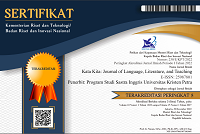The Development of Indonesian Horror Film Narratives “SI MANIS JEMBATAN ANCOL” in 1994 and 2019
DOI:
https://doi.org/10.9744/katakita.13.1.182-190Abstract
This study explores the evolution of Indonesian horror film narratives by comparing Si Manis Jembatan Ancol (1994) and its 2019 remake. The 1994 version employs a lighter, entertainment-focused approach, emphasizing traditional supernatural elements with a straightforward storyline. In contrast, the 2019 film presents a complex narrative, incorporating social and psychological themes with nuanced characters. This transformation mirrors shifting audience preferences toward more emotional and realistic storytelling. The study also examines the impact of social, cultural, and technological factors on these narratives. The 1994 film reflects local traditions and beliefs, while the 2019 version integrates advanced CGI and contemporary social issues, influenced by global trends. Technological advancements in the remake enhance its visual and emotional depth, creating a more immersive horror experience. Ultimately, the study highlights how Indonesian horror films evolve in response to technological progress, cultural shifts, and the changing tastes of audiences over time.
Downloads
Published
Issue
Section
License
Authors who publish with this journal agree to the following terms:- Authors retain copyright and grant the journal right of first publication with the work simultaneously licensed under a Creative Commons Attribution License that allows others to share the work with an acknowledgement of the work's authorship and initial publication in this journal.
- Authors are able to enter into separate, additional contractual arrangements for the non-exclusive distribution of the journal's published version of the work (e.g., post it to an institutional repository or publish it in a book), with an acknowledgement of its initial publication in this journal.
- Authors are permitted and encouraged to post their work online (e.g., in institutional repositories or on their website) prior to and during the submission process, as it can lead to productive exchanges, as well as earlier and greater citation of published work (See The Effect of Open Access).














